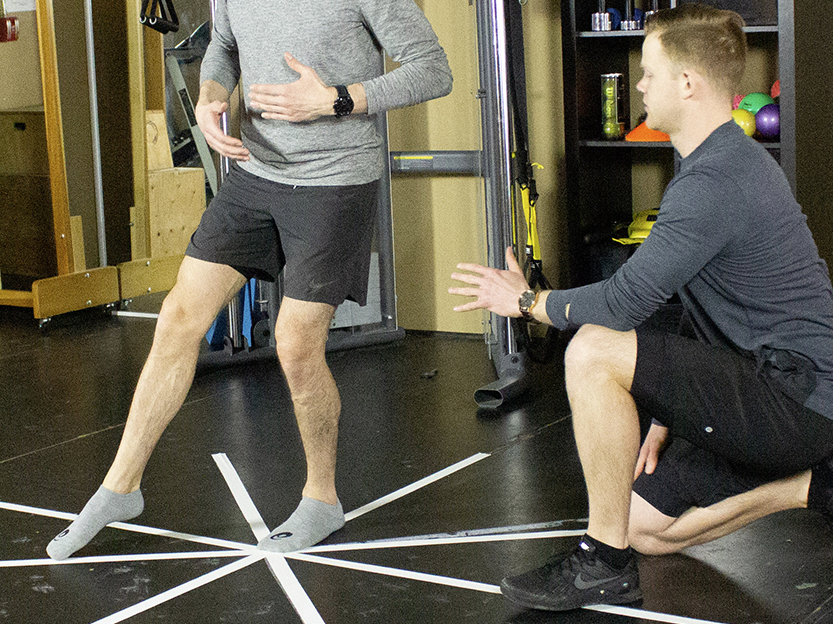Physical therapists can help individuals recoup strength, suppleness and steadiness in the damaged joint after an ankle sprain through targeted rehabilitation. Ankle sprains are common injuries that can result from sports activities or everyday mishaps, leading to acute pain and movement coordination impairments. By following personalized rehabilitation programs designed by physical therapists, patients can experience reduced pain levels and improved muscle strength.
In this blog post, we will explore the importance of physical therapy for ankle sprain recovery and delve into various treatment options such as RICE therapy (Rest, Ice, Compression, Elevation) and NSAIDs (Nonsteroidal Anti-Inflammatory Drugs). We will also discuss different exercise programs targeting specific muscles surrounding the injury site to promote healing effectively.
Furthermore, we’ll compare various ankle sprain rehabilitation programs aimed at preventing recurrent injuries while highlighting the role of physical therapists in monitoring progress throughout the recovery process. Ultimately providing valuable insights on how you can achieve a full recovery from an ankle sprain through proper guidance and commitment to your physical therapy regimen.
The Importance of Physical Therapy for Ankle Sprains
Seeking assistance from a physical therapist can expedite the recovery process and help you regain strength, flexibility, and endurance while preventing future ankle sprains. A professional can help you regain strength, flexibility, and endurance while preventing future ankle sprains. Let’s dive into the common causes of ankle sprains and the long-term effects if left untreated.

Common Causes of Ankle Sprains
Ankle sprains happen when your foot twists or rolls inwards, damaging one or more ligaments on the outer side of the ankle. These include the anterior talofibular ligament and calcaneofibular ligament. Some common causes of these injuries include:
- Falling or suddenly changing direction during sports activities.
- Walking or running on uneven surfaces.
- Poorly fitting shoes or lack of proper support during exercise.
- Weakened muscles around the ankles due to previous injury or inadequate conditioning.
Long-Term Effects If Left Untreated
If you don’t treat your ankle sprain with physical therapy and appropriate rehabilitation programs, you could face chronic issues such as:
- Movement coordination impairments: You might lose your balance and control over joint movements, leading to recurrent lateral ankle sprains that further weaken surrounding structures like tendons and muscles.
- Chronic ankle instability: You might feel like your ankle is “giving way” during everyday activities or sports, leading to a higher risk of reinjury.
- Osteoarthritis: Long-term damage to the joint cartilage may cause pain and stiffness in the affected area, limiting mobility and affecting overall quality of life.
To avoid these complications, it’s crucial to seek professional help from a physical therapist who can design tailored rehabilitation programs that address your specific needs. These programs aim to reduce pain, improve muscle strength around the affected joint(s), restore normal gait patterns, and enhance overall endurance levels. By following such personalized treatment plans under expert guidance, you can significantly increase your chances of making a full recovery while minimizing risks associated with untreated injuries.
Ankle sprains can take up to a year to heal, but physical therapy can speed up the process and prevent future injuries. Common causes of ankle sprains include sports activities, walking or running on uneven surfaces, poorly fitting shoes, and weakened muscles around the ankles. If left untreated, ankle sprains can lead to chronic issues such as movement coordination impairments, chronic ankle instability, and osteoarthritis. Seeking professional help from a physical therapist is crucial for tailored rehabilitation programs that address specific needs and increase chances of making a full recovery while minimizing risks associated with untreated injuries.
Initial Treatment with RICE Therapy and NSAIDs
Ankle sprains are a pain, especially for travel bloggers like us. To treat acute ankle sprains, start with non-surgical management using RICE therapy (Rest, Ice, Compression, Elevation). This approach helps reduce inflammation and pain while promoting healing. NSAIDs, like other analgesics, may be employed during the initial phase of treatment to help alleviate discomfort.
Components of RICE therapy
- Rest: Avoid putting weight on the injured ankle as much as possible. Use crutches or a walking boot if necessary to keep pressure off the area.
- Ice: Apply ice packs to the affected area for 15-20 minutes at a time every few hours during the first couple of days after injury. Be sure to wrap the ice pack in a thin towel or cloth to prevent frostbite.
- Compression: Wear an elastic bandage around your ankle to help control swelling and provide support. Don’t wrap it too tight – you don’t want to cut off circulation.
- Elevation: Keep your foot elevated above heart level whenever possible during rest periods. This will help minimize swelling by encouraging blood flow back towards your heart.
The goal of RICE therapy is not only pain relief but also preventing further damage while allowing natural healing processes to take place.
Appropriate use of NSAIDs
In addition to following RICE protocol, using NSAIDs can help manage pain and inflammation. Common over-the-counter NSAIDs include ibuprofen (e.g., Advil, Motrin) and naproxen (e.g., Aleve). These medications work by blocking the production of prostaglandins, which cause inflammation and pain.
When using NSAIDs for ankle sprains:
- Always adhere to the dosage instructions provided by your healthcare provider or on the label when taking NSAIDs for ankle sprains.
- Try to avoid combining multiple NSAIDs, as this may lead to adverse reactions such as abdominal discomfort or bleeding.
- Before beginning any new medication, it is important to consult with your doctor if you have a history of gastrointestinal issues, kidney problems, or other health concerns.
In some cases, surgical intervention may become necessary for more severe injuries like torn ligaments. However, this is generally reserved only when conservative treatments fail after an extended period. Remember to seek professional help from a physical therapist during the recovery process. They can create personalized exercise programs tailored specifically towards regaining strength around affected joint(s), improving flexibility throughout the entire range of motion, and enhancing overall endurance levels needed to return to sports activities without the risk of reinjury.
To treat ankle sprains, start with RICE therapy (Rest, Ice, Compression, Elevation) and NSAIDs to reduce inflammation and pain. Follow the recommended dosage instructions on the label or as directed by your healthcare provider when using NSAIDs. Seek professional help from a physical therapist during recovery for personalized exercise programs tailored towards regaining strength around affected joint(s), improving flexibility throughout the entire range of motion, and enhancing overall endurance levels needed to return to sports activities without risk of reinjury.
Regaining Mobility Through Personalized Exercise Programs
But fear not. With the right guidance from a physical therapist, you can quickly get back to your favorite sports activities with ease. Once the initial swelling has gone down, it’s time to start working on regaining mobility through exercise programs designed specifically for you. These personalized programs aim to restore normal gait patterns, improve muscle strength, and enhance overall endurance levels.
Assessing Individual Needs for Exercise Program Design
A thorough assessment of your individual needs is crucial in designing an effective ankle sprain rehabilitation program. Your physical therapist will consider factors such as the severity of your injury, any pre-existing conditions or movement coordination impairments that may have contributed to the sprain, and your personal goals for recovery. By taking all these aspects into account, they’ll create a tailored plan that addresses both short-term pain relief and long-term functional improvement.
Types of Exercises Typically Included in Rehabilitation Plans
- Range of motion exercises: Get those ankles moving with gentle exercises that promote flexibility in surrounding muscles. Examples include ankle circles or tracing letters with your toes.
- Muscle strengthening exercises: Build up muscle strength around the injured area to support those ligaments like anterior talofibular ligament (ATFL) and calcaneofibular ligament (CFL). Common strengthening exercises involve resistance bands or bodyweight movements such as calf raises.
- Balance and proprioception exercises: Improve your sense of body position and movement coordination to prevent future ankle sprains. Examples include single-leg balance drills or standing on a wobble board.
- Functional training: As you progress in your recovery, functional exercises that mimic everyday movements or sports-specific actions will be incorporated into your program. This might involve lateral hops for basketball players or agility ladder drills for soccer enthusiasts.
In addition to these core components, physical therapists may also recommend other strategies such as taping techniques to provide additional support during the healing process. Remember that each person’s rehabilitation journey is unique – what works well for one individual may not be suitable for another with different circumstances. Consequently, it is essential to collaborate with your therapist for the entire rehabilitation process and communicate any issues or worries that may arise.
Ankle sprain rehabilitation programs not only help you recover from an acute injury but also set the foundation for long-term prevention of chronic ankle instability issues down the line. By following a personalized exercise plan under professional guidance, you’ll increase muscle strength and reduce pain levels – ultimately allowing you to return confidently to your favorite sports activities without fear of reinjury. So, let’s get those ankles back in action.
Get back on your feet after an ankle sprain with the help of a physical therapist. They will design a personalized exercise program that includes range of motion, muscle strengthening, balance and proprioception exercises, and functional training to improve mobility and prevent future injuries. By following this tailored plan under professional guidance, you’ll be able to confidently return to your favorite sports activities without fear of reinjury.
Preventing Recurrent Ankle Sprains with Exercise Therapy
Ankle sprains suck. They hurt, they swell, and they make you feel unstable. But fear not. A recent study found that exercise therapy can significantly reduce your risk of reinjury. Let’s take action and prevent those bothersome ankle sprains from recurring.
Key Findings from the Study on Exercise Therapy Effectiveness
- Exercise therapy reduces recurrent ankle sprains compared to rest and ice.
- It improves muscle strength, movement coordination, and endurance levels.
- Exercise therapy should be included in all rehabilitation programs to prevent chronic ankle instability and improve sports activities participation.
Strategies to Prevent Recurrence
Working with a physical therapist is crucial to design an individualized program tailored specifically for you. Here are some key strategies:
- Muscle strengthening exercises: Improve muscle strength in your lower leg and foot to provide additional support to your ligaments. Examples include heel raises, toe curls, and resisted band exercises.
- Balance and proprioception training: Incorporate balance exercises like single-leg stands, wobble board exercises, or yoga poses to improve your body’s awareness of its position in space.
- Mobility work: Address any movement restrictions by working on ankle joint mobility through self-mobilization techniques or with the help of a physical therapist.
- Plyometric exercises: Add jumping exercises to enhance power production and reduce pain during sports activities. Progress these exercises gradually to avoid reinjury.
Proper footwear is also essential to provide ample support for your feet during physical activity. Advice from an orthopedic professional or foot doctor may be needed.
Recovering from an ankle sprain requires rest, good nutrition, hydration, and stress management. By following these guidelines and participating in a comprehensive rehabilitation program, you can significantly reduce your risk of recurrent ankle sprains and chronic instability issues. So, let’s get moving.
Exercise therapy can significantly reduce the risk of reinjury and improve muscle strength, movement coordination, and endurance levels. Working with a physical therapist is crucial to design an individualized program tailored specifically for you that includes muscle strengthening exercises, balance training, mobility work, plyometric exercises and proper footwear. By following these guidelines and participating in a comprehensive rehabilitation program one can significantly reduce their risk of recurrent ankle sprains and chronic instability issues.
Comparing Different Rehabilitation Programs for Ankle Sprain Recovery
Ankle sprains are a common injury, and finding the most effective rehabilitation program is crucial to ensure a full recovery. With the wide range of options available, it can be difficult to decide which one is best suited for your recovery. Let’s take a closer look at some of the most popular approaches:
Overview of different rehabilitation programs
- Traditional physical therapy: This is the classic approach to rehab, with exercises that focus on range of motion, muscle strengthening, balance, and functional training. Manual therapy techniques like joint mobilization or soft tissue manipulation may also be used.
- Plyometric exercise programs: These high-intensity workouts are all about power, using explosive movements to rapidly stretch and contract muscles. They can help increase muscle strength and endurance around the affected joint(s).
- Taping/bracing protocols: External support devices like tape or braces can provide additional stability for injured ligaments while allowing you to continue participating in sports activities safely.
- Aquatic therapy: Exercising in water can reduce pain and provide resistance to help improve muscle strength. It’s a great option for those who have difficulty tolerating weight-bearing activities early in their rehab journey.
Factors to consider when choosing a rehab plan
- Severity of injury: The extent of ligament damage will influence the recommended treatment approach. More severe injuries may require a longer period of immobilization before beginning exercise therapy.
- Patient goals: Consider what activities you want to return to after recovering from an ankle sprain and choose a program that aligns with these objectives.
- Availability of resources: Access to specialized equipment or facilities can impact which rehab programs are feasible options for you.
- Prior experience with rehab techniques: If you’ve had success using specific methods in the past, it might be worth incorporating them into your current recovery plan.
Remember, the most effective approach will depend on your individual circumstances. Consult with a qualified healthcare professional like a physical therapist to get personalized recommendations. And don’t be afraid to seek out multiple opinions – finding the right rehab program can make all the difference in your recovery.
When recovering from an ankle sprain, choosing the right rehabilitation program is crucial for a full recovery. Different options include traditional physical therapy, plyometric exercise programs, taping/bracing protocols and aquatic therapy; factors to consider when choosing a rehab plan include severity of injury, patient goals, availability of resources and prior experience with rehab techniques. It’s important to consult with a qualified healthcare professional like a physical therapist for personalized recommendations.
The Role of Manual Therapy and Complementary Therapies
Aside from exercise therapy, manual therapy techniques like joint mobilization or soft tissue manipulation can help patients recover from ankle sprains. Complementary modalities, like acupuncture or massage, may be employed to facilitate the healing process. Let’s delve into how these alternative treatments can enhance a patient’s recovery plan.
Benefits of Manual Therapy Techniques
- Joint Mobilization: Applying gentle pressure on the affected joint(s) can restore normal range of motion. Joint mobilization is useful for treating movement coordination impairments that often result from chronic ankle instability.
- Soft Tissue Manipulation: This technique addresses muscle imbalances around the injured area by releasing tight muscles and stimulating underactive ones. It helps reduce pain while improving overall muscle strength and flexibility.
A recent study found that incorporating manual therapy into ankle sprain rehabilitation programs led to significant improvements in patient-reported outcomes, including reduced pain levels and increased function. Therefore, it’s worth considering adding these techniques to your recovery plan if you’re struggling with persistent symptoms after an acute ankle sprain.
Exploring Complementary Therapies for Recovery
Beyond traditional physical therapy methods, several complementary therapies may help alleviate pain and improve overall well-being during the recovery process:
- Acupuncture: This ancient Chinese practice involves inserting thin needles into specific points on the body to stimulate natural healing processes. Acupuncture has been shown to be effective in reducing pain and inflammation associated with ankle sprains. However, it’s essential to seek treatment from a licensed acupuncturist who is experienced in treating musculoskeletal conditions.
- Massage Therapy: Massage can help relax tight muscles, increase blood flow to injured tissues, and promote relaxation. A systematic review found that massage therapy could effectively reduce pain levels in patients recovering from lateral ankle sprains. Be sure to find a certified massage therapist who specializes in sports injuries for optimal results.
Incorporating manual therapy techniques and complementary therapies like acupuncture or massage into your rehabilitation plan can provide additional support during your recovery journey after an ankle sprain. It’s important to discuss these options with your physical therapist or healthcare provider before trying them out so they can tailor their recommendations based on your unique needs and preferences.
Manual therapy techniques such as joint mobilization and soft tissue manipulation can aid in ankle sprain recovery, according to a recent study. Complementary therapies like acupuncture or massage may also provide relief during the healing process by reducing pain levels and promoting relaxation.
FAQs in Relation to Physical Therapy for Ankle Sprain
How Physical Therapy Helps Ankle Sprains
Physical therapy reduces pain and inflammation, restores strength and flexibility, improves balance, and prevents future injuries through RICE therapy, NSAIDs, and personalized exercise programs.
The 5 Stages of Rehabilitation for a Sprained Ankle
- Pain relief and protection
- Range-of-motion restoration
- Muscle strengthening
- Balance training
- Sport-specific functional exercises
Duration of Physical Therapy for a Sprained Ankle
The duration of physical therapy varies depending on the severity of the injury, ranging from 2-6 weeks for mild to moderate cases and several months for severe cases.
Rehab Protocol for a Sprained Ankle
Rehab protocol involves RICE therapy followed by customized exercise programs targeting weak muscles surrounding the injury site, focusing on regaining strength, flexibility, and balance while monitoring progress throughout recovery.
For more information on ankle sprain physical therapy, check out Move Forward PT.
Conclusion
Don’t let an ankle sprain keep you down – physical therapy is key! With a personalized exercise program from a physical therapist, you can regain strength and flexibility while preventing future injuries. RICE therapy and NSAIDs help reduce swelling and promote healing.
Consistent exercise therapy is crucial for long-term recovery from ankle sprains. Target specific muscles with rehabilitation programs like plantar fascia exercises or tibialis anterior exercises. Physical therapists monitor progress and adjust exercise programs as needed.


